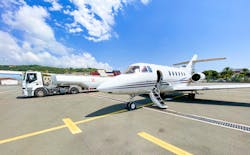Common Fueling Mistakes and How to Avoid Them
What type of fuel does an aircraft use?
The answer should be straightforward.
However, in 2009, a Cessna 421C incorrectly fueled with 80 gallons of Jet A fuel instead of 100LL avgas led to a loss of engine power. Unable to return to a runway, the pilot landed the plane in an open field. The airplane was substantially damaged, and the pilot and two passengers sustained minor injuries.
The National Transportation Safety Board (NTSB) determined the probable cause of the accident to be “the failure of line personnel to ensure that the airplane was serviced with the proper fuel.” Contributing to the accident was the Federal Aviation Administration’s (FAA) approval of a Supplemental Type Certificate, which allowed an improper fuel filler opening, and the complacency in non-standard fueling practices by the fixed-base operator (FBO) line personnel.
As one of about 50 regional air safety investigators with the NTSB, Joshua Lindberg’s job is to investigate incidents like these.
“One of the things we always look at and try to track down is the type of fuel being used to make sure that it was the proper fuel,” Lindberg says.
The reasons that fuel is misidentified or misfueling occurs are different in most every case, he explains, but when the wrong fuel is used, that’s almost always a factor in the accident.
“We have a lot of roles and wear a lot of different hats,” he says, “but generally we document accident sites, gather all the perishable evidence that’s available, interview witnesses and take a lot of photos and then write the final accident report.”
While investigators do many things, Lindberg says the main goal is accident prevention.
Because several fueling-related mistakes came to their attention, in part, because of accident investigations, NTSB issued two misfueling safety alerts - Line Personnel: Fueling Matters (SA-051) and Pilots: Fueling Mistakes (SA-050). NTSB also issued a safety alert (SA-079) about diesel exhaust fluid (DEF) and how it was being mislabeled or not labeled at all at airports. As a result, it was inadvertently added to airplanes.
According to Lindberg, misfueling mistakes investigators are seeing today include:
- Fuel trucks being outfitted with the wrong fuel nozzles
- Fuel nozzles being swapped between trucks
- Airplanes not being placarded correctly or not having placards at all
- Airplanes misidentified by line service personnel
- Airplanes outfitted with supplemental type certificates (STCs), which allow them to change the type of engine that is on the airplane, which, in turn, could change the type of fuel required.
The fuel filler openings of the Cessna 421C were modified in accordance with airworthiness directive 87-21-02 R1 to prevent the "flattened" Jet A fuel nozzles from entering the fuel filler ports.
The placard near the right main fuel tank filler cap was worn and unreadable.
The final NTSB report for the Cessna 421C accident (CEN09LA145) notes: “Two medium single-engine general aviation airplanes based at the FBO had been modified with turbo-prop engines requiring Jet A fuel. The two modified airplanes were not required by Supplement Type Certificate to modify the fuel filler opening, allowing the airplane to operate with smaller fuel filler openings, which did not comply with certification regulations.”
The FBO's Jet A fuel truck had the "flattened" nozzle. Line personnel at the FBO discovered that by rotating the Jet A nozzle and dispensing at a reduced pressure, Jet A fuel could be dispensed without using the adapter. This method became the normal way for the line person involved to refuel the two modified PA-46 airplanes. The line tech reported that he incorrectly thought the effected aircraft required Jet A fuel despite having refueled that airplane several times previously.
Although FBO line personnel had correctly fueled the accident airplane in the past, the line technician mistook the airplane for one of the converted aircraft.
In two other cases, Lindberg says the fuel trucks being used were outfitted with the wrong nozzles.
“What we found on those two cases were that there were turbine helicopters at these airports and those turbine helicopters were easier to fuel with the 100LL skinny-type nozzle,” he says. “However, they were needing Jet A fuel, so the line service personnel would swap the nozzles to make it easier to fuel and then would never swap them back or would forget to swap them back. And then, when they needed to go fill a different airplane, they had the wrong nozzle on there. They were using the wrong truck. There was nothing really to help them identify that they were misfueling this airplane.”
Safeguards
Today, there are a number of safeguards that can be put in place to prevent misfueling.
Fuel nozzles for Jet A and 100LL offer different designs. Jet A requires a larger “duck bill” nozzle while 100LL requires a skinny, round nozzle.
As long as those are installed correctly on the trucks, Lindberg says they are a valuable safeguard to prevention misfueling.
Both fueling trucks and airplanes are color-coded. Black indicates Jet A. Red indicates 100LL.
“If you’ve got black on black and red on red, you know you’ve got the correct nozzle going into the correct airplane,” he says.
Also, he adds fuel filler port restrictors on many airplanes that use 100LL make the fuel filler port small and very restricted so that it can only fit the small 100LL nozzle. The larger Jet A duck bill nozzle cannot fit inside.
Decals are another safeguard and should come standard on every airplane, Lindberg says.
“If you don’t have a placard near your fuel filler port , then it’s something that you should absolutely add,” he says. “That’s one of those things that can help line service personnel quickly identify the type of fuel and it just adds to the number of safeguards that we’ve already got in place.”
Who’s Responsible?
“The FAA regulations state that the pilot in command is ultimately responsible for the safety of their flight,” Lindberg explains. “However, the aviation industry is all about a team effort and we work towards a common goal of safety and accident prevention, which is obviously best for everyone. So, at the end of the day, if we can all share their responsibility and make it about teamwork, then the aviation industry will be safer.”
Frequent and high-quality training is the best method for avoiding fueling mistakes, he says.
“The National Air Transportation Association (NATA) has a very good misfueling prevention program on their website that provides free training and resources. I would highly recommend this to all line service personnel to take either annually or quarterly, whatever is in their training program. But this is one of those that should absolutely be included. And this is something that pilots also can take. It’s a free program and it can help them identify misfueling issues and work with line personnel, as they are fueling their airplanes,” Lindberg says.
“Short cuts are never a good thing,” he adds. “Getting in a rush is never a good thing, and we’ve seen that those can contribute to accidents as well. So, we’d like to make sure that we slow down, ask all the right questions.”
Lindberg advises that ground handlers always have a discussion with the pilot for every fueling event.
“It’s an opportunity for you to communicate with somebody else that’s in the aviation industry. You’ve got like interests and common goals,” Lindberg says. “Always have a discussion with them because that discussion can start all of the questions that are necessary to ensure the proper fueling happens. That directly ties into the fact that the aviation industry is a team effort and everyone has an important role to play. We want to make sure that everyone is equally informed and prepared so that everybody appreciates the magnitude of their responsibilities, line service personnel absolutely included.”
Lastly, he reminds ground service providers to never assume anything.
“You may have seen a certain type of airplane or a certain type of fueling truck, or whatever the case, maybe 100 or 100,000 different times. But that one time you interact with a different type of airplane, and you think you know exactly what type of fuel it needs is probably the time that an accident is going to happen,” Lindberg warns. “So never assume that you know the type of airplane or the type of fuel an airplane needs. Always ask, always get a conversation started with the pilot.”
Learn More
- General Aviation Misfueling Prevention Program, National Air Transportation Association (NATA)
- “EI Recommended Practice 1597 Procedures for Overwing Fueling to Ensure Delivery of the Correct Fuel Grade To An Aircraft,” Energy Institute (EI)
- Preventing FSII Contamination with DEF, NATA
- “Fuel Management: Go Beyond the Textbook — Be Fuel Aware With This Safety Spotlight,” Aircraft Owners and Pilots Association (AOPA) –
- Safety 1st Fuel QC Management System, NATA
About the Author
Rebecca Kanable
Assistant Editor
Rebecca Kanable, a veteran journalist, worked with Endeavor Business Media's aviation group from 2021 to 2024 as assistant editor of Airport Business, AMT and Ground Support Worldwide. She previously worked for various publications, including trade magazines and newspapers.

